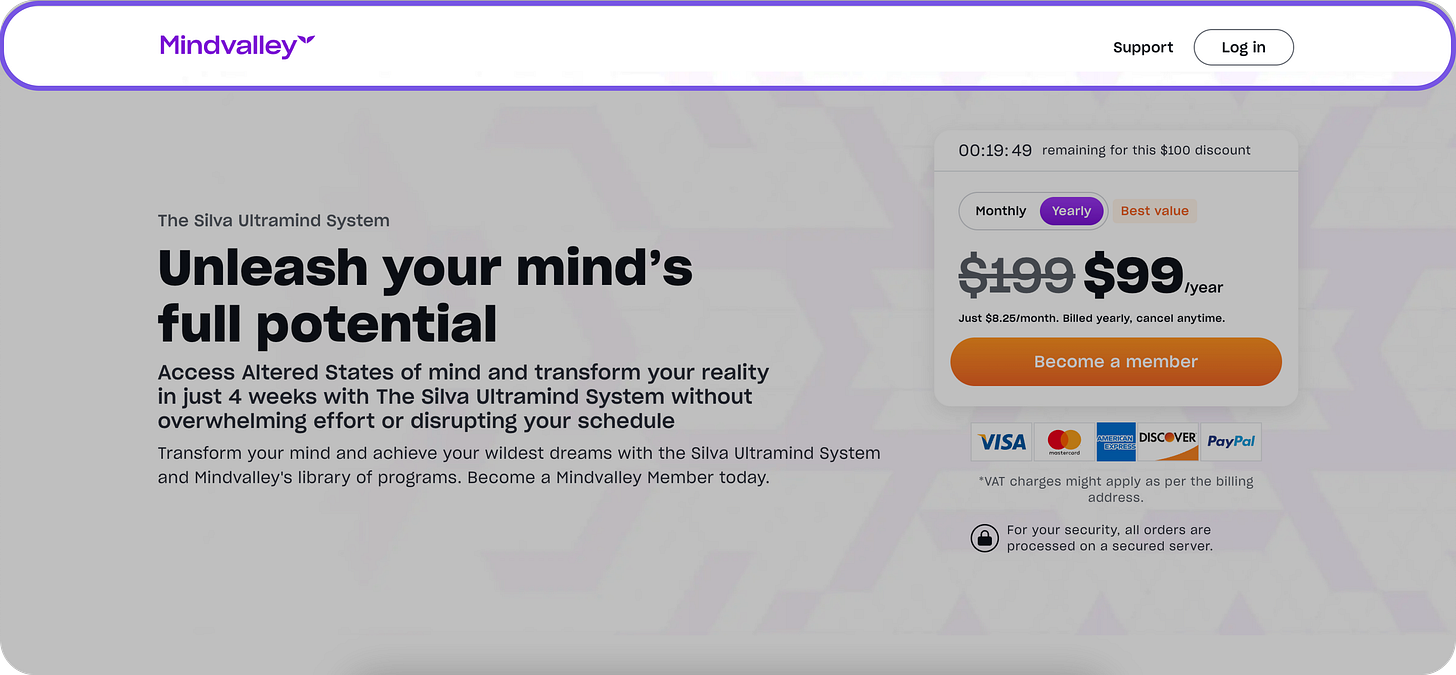Growth Tactics of a $150m Revenue Bootstrapped SaaS Company
Breaking Down the Best Paid Acquisition Funnel in the World
👋 Henry here, welcome to B2B Growth Insights, where I take my learnings from being at Pricepoint Partners to showcase how the best B2B SaaS companies do pricing, growth, and retention.
Insights from today’s article:
🗺️ How MindValley Scaled Solely w/ Facebook Ads
📊 A Super High Converting Purchase Page
🕵️ Why They Remove the Navigational Header on their Site
A Deep Dive into Their Customer Acquisition Machine
When you think of successful SaaS companies, your mind probably jumps to Silicon Valley, venture capital, and Ivy League founders. MindValley breaks every one of these rules.
Based in Tallinn, Estonia, and founded by Vishen Lakhiani, MindValley has built a $150 million annual revenue business selling what they call "the Netflix of self-improvement" - without ever raising capital or employing traditional enterprise sales tactics.
But here's what's fascinating: they've achieved this massive scale not through product virality or engineering resources, but by mastering something most SaaS companies struggle with - paid acquisition at scale.
Let's dive into how they've built this customer acquisition machine...
The Secret Sauce: Video Sales Letters
MindValley spends a staggering $5+ million per month just on YouTube and Facebook ads. But what caught my attention isn't the spend - it's how they're spending it.
They've cracked the code on something most marketers consider impossible: getting cold traffic to watch 30-45 minute sales videos on Facebook.
Here's what makes their VSL (Video Sales Letter) strategy unique:
Instead of the traditional "short teaser → landing page → form fill" funnel, they keep users on Facebook
They've mastered creating hooks compelling enough to maintain attention for 45+ minutes
The videos take viewers through a complete journey: problem awareness → education → pain points → solution
Users go straight from video to purchase page, eliminating friction
What's particularly clever is how they've adapted this strategy specifically for Facebook. On YouTube, videos longer than 2 minutes get penalized with higher CPMs (they reduce YouTube's ad load capacity). But Facebook? No such restriction.
The Conversion Engine: Anatomy of Their Buy Page
Now, this is where things get really interesting. MindValley's buy page breaks several conventional SaaS design rules - and it works brilliantly.
First thing you'll notice? What's missing.
Unlike typical SaaS landing pages cluttered with navigation links to pricing, documentation, and use cases, MindValley strips everything away. The only links you'll find are:
Chat with support (smart conversion tactic for fence-sitters)
Login for existing users
Above the fold, it's ruthlessly minimal: just a header, subheader, and buy button. No fancy UI mockups or flashy graphics to distract from the conversion goal.
The Psychology of Their Pricing Display
This is where MindValley really flexes their e-commerce muscles. They employ several psychological triggers:
Artificial scarcity: There's always a countdown timer for a "limited time discount" (I've checked multiple times while writing this - it's consistently there)
Dollar savings vs percentage: They show the actual dollar amount saved rather than a percentage. Why? Because $XX saved feels more tangible than Y% off which makes the take-up rate of this offer far higher.
Annual plan anchoring: They default to annual pricing, which:
Reduces churn
Increases lifetime value
Dramatically improves cash flow (getting $99 upfront versus waiting 4 months at $29/month)
Price framing: They break down the annual cost to $8.25/month - a classic e-commerce tactic borrowed from supplement companies (think "only $0.66 per day!")
The Upsell Master Class
Here's where MindValley's revenue engine gets really interesting. While their platform and courses typically run $100-300 annually, they've built a sophisticated upsell machine:
Masterminds and group coaching programs ranging from $2,000 to $50,000
Even a 1% conversion rate on $5k upsells boosts revenue by 25%
This strategy has become increasingly crucial as Facebook CPMs rise and day-1 profitable acquisition gets harder.
Content Strategy: The Credibility Hack
Instead of building expertise from scratch, MindValley partners with experts in each field. This two-pronged approach:
Borrows established credibility from industry experts
Reduces customer acquisition costs through shared authority
The Checkout Experience
The final step in their funnel shows the same obsessive focus on conversion. Their checkout page is simple but strategic, featuring:
Clear display of the discount
Three prominent objection handlers (in attention-grabbing purple):
15-day refund policy
Safe & secure checkout
Active support team
While these trust badges might seem unnecessary for B2B SaaS, MindValley knows their consumer audience. These simple elements can boost conversion rates by 5% in consumer and PLG SaaS markets.
What Can We Learn?
MindValley's funnel success comes down to a few key principles:
Mastery of platform-specific ad strategies (45-minute Facebook VSLs)
Ruthless focus on conversion (stripping away distractions)
Smart psychological pricing triggers
Strategic upsells to boost LTV
Borrowed credibility through expert partnerships
They've proven that with the right funnel optimization, you don't need Silicon Valley's traditional success ingredients to build a $150M SaaS business.












